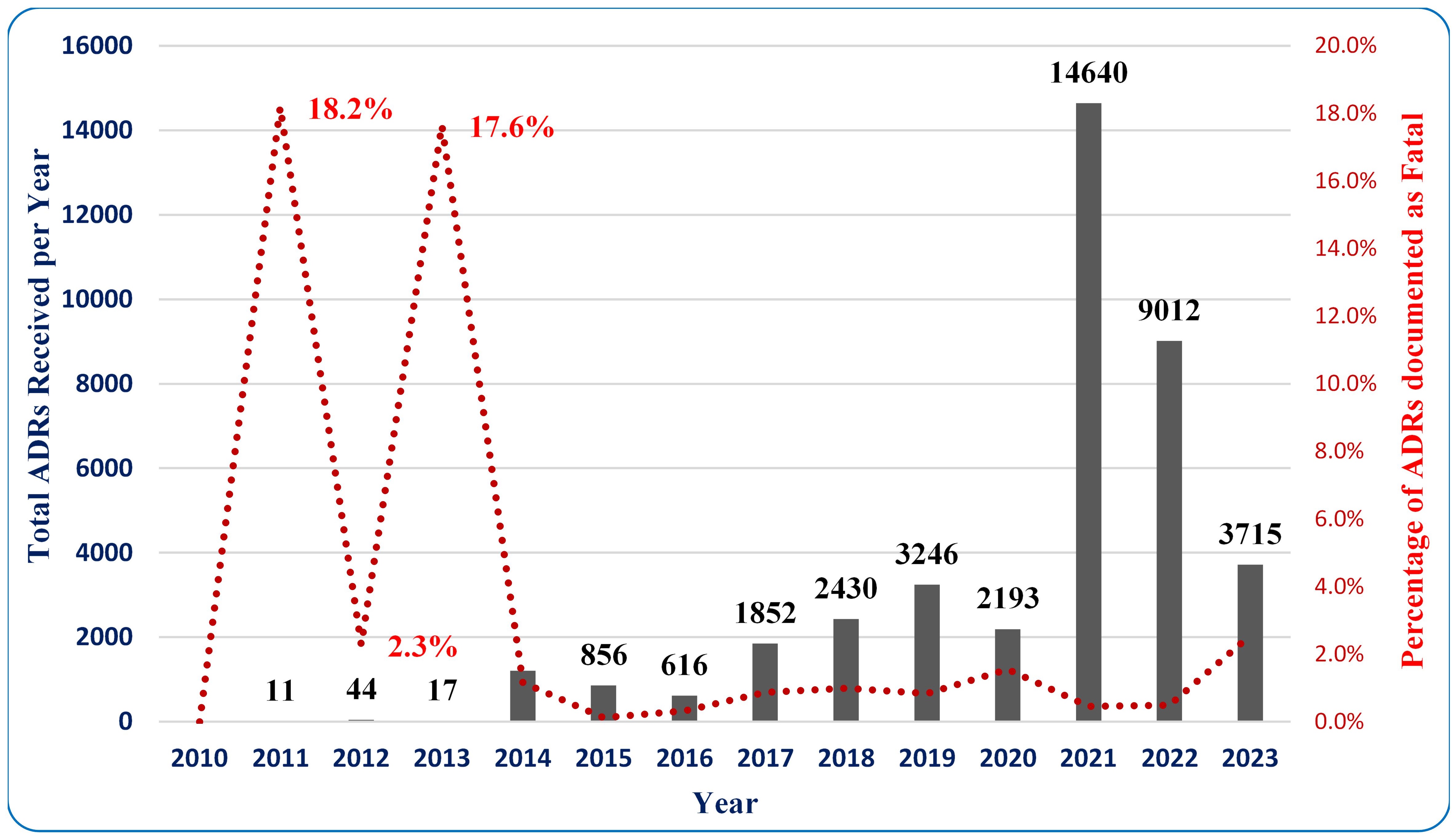Mortality Rate Related to Adverse Drug Reactions in Iraqi Patients: A Study Based on WHO Database
DOI:
https://doi.org/10.54133/ajms.v6i2.725Keywords:
ADR, fatal, pharmacovigilance, Iraq, VigiBase, mortalityAbstract
Background: Adverse drug reactions (ADRs) are unintended harmful effects caused by medications that can occur at any dose. ADRs are a significant contributor to hospital admissions and are responsible for numerous fatalities, particularly among older adults with multiple chronic illnesses who take multiple medications. Reporting ADRs is critical for identifying the harmful effects of medications and monitoring patients in hospitals. Objective: ADRs have a significant impact on mortality rates, but no previous studies in Iraq have focused on death-related reports. To address this problem, we conducted a study to assess mortality rates associated with ADRs in Iraq and identify the drugs most frequently involved. Methods: We collected the ADR reports of Iraqi patients that were registered as fatal from January 2010 to January 2024 in the World Health Organization (WHO) pharmacovigilance database, VigiBase. The case-non-case method will be used to investigate the reporting risk in Iraq versus the rest of the world. Results: A total of 329 fatal ADRs were found, and the mean age of affected patients was 36 years, with a male-to-female ratio of 1.25:1. Antineoplastic agents ranked first among drugs that caused fatal ADRs (38.4%), and pembrolizumab was the leading active ingredient (27 cases, 6.85%). Conclusions: This study is the first to identify and describe fatal ADRs in Iraq and found them less common in Iraq, and the risk is lower in Iraqi women compared to Iraqi men.
Downloads
References
Laroche ML, Gautier S, Polard E, Rabier MB, Chouchana L, Lebrun-Vignes B, et al. Incidence and preventability of hospital admissions for adverse drug reactions in France: A prospective observational study (IATROSTAT). Br J Clin Pharmacol. 2023;89(1):390-400. doi: 10.1111/bcp.15510. DOI: https://doi.org/10.1111/bcp.15510
Angamo MT, Chalmers L, Curtain CM, Bereznicki LR. Adverse-drug-reaction-related hospitalisations in developed and developing countries: A review of prevalence and contributing factors. Drug Saf. 2016;39(9):847-857. doi: 10.1007/s40264-016-0444-7. DOI: https://doi.org/10.1007/s40264-016-0444-7
R JC, M BD. A study to analyze the pattern, causality, severity, predictability and preventability of adverse drug reactions among patients attending department of obstetrics and gynecology at a tertiary care hospital. Natl J Physiol Pharm Pharmacol. 2019;9(2):172-177. doi:10.5455/njppp.2019.9.1236921122018. DOI: https://doi.org/10.5455/njppp.2019.9.1236921122018
Iftikhar S, Sarwar MR, Saqib A, Sarfraz M. Causality and preventability assessment of adverse drug reactions and adverse drug events of antibiotics among hospitalized patients: A multicenter, cross-sectional study in Lahore, Pakistan. PLoS One. 2018;13(6):e0199456. doi: 10.1371/journal.pone.0199456. DOI: https://doi.org/10.1371/journal.pone.0199456
Alomar MJ. Factors affecting the development of adverse drug reactions (Review article). Saudi Pharm J. 2014;22(2):83-94. doi: 10.1016/j.jsps.2013.02.003. DOI: https://doi.org/10.1016/j.jsps.2013.02.003
Sokolewicz EM, Rogowska M, Lewandowski M, Puchowska M, Piechota D, Barańska-Rybak W. Antibiotic-related adverse drug reactions in patients treated on the dermatology ward of Medical University of Gdańsk. Antibiotics (Basel). 2021;10(10):1144. doi: 10.3390/antibiotics10101144. DOI: https://doi.org/10.3390/antibiotics10101144
Reps JM, Garibaldi JM, Aickelin U, Gibson JE, Hubbard RB. A supervised adverse drug reaction signalling framework imitating Bradford Hill's causality considerations. J Biomed Inform. 2015;56:356-368. doi: 10.1016/j.jbi.2015.06.011. DOI: https://doi.org/10.1016/j.jbi.2015.06.011
Verma R, Vasudevan B, Pragasam V. Severe cutaneous adverse drug reactions. Med J Armed Forces India. 2013;69(4):375-383. doi: 10.1016/j.mjafi.2013.01.007. DOI: https://doi.org/10.1016/j.mjafi.2013.01.007
Dubrall D, Just KS, Schmid M, Stingl JC, Sachs B. Adverse drug reactions in older adults: a retrospective comparative analysis of spontaneous reports to the German Federal Institute for Drugs and Medical Devices. BMC Pharmacol Toxicol. 2020;21(1):25. doi: 10.1186/s40360-020-0392-9. DOI: https://doi.org/10.1186/s40360-020-0392-9
Schubert C, Desai M, Patwardhan M, Lievano F, Islam SS, Chand DH, et al., (Eds.), Causality assessment and examples of adverse drug reactions (drug-induced liver injury, renal, skin, and major adverse cardiac events), In: Pharmacovigilance: A Practical Approach, Elsevier; 2018. p. 47–67. doi: 10.1016/B978-0-323-58116-5.00004-3. DOI: https://doi.org/10.1016/B978-0-323-58116-5.00004-3
Gautron S, Wentzell J, Kanji S, Nguyen T, Kobewka DM, MacDonald E. Characterization of serious adverse drug reactions in hospital to determine potential implications of mandatory reporting. Can J Hosp Pharm. 2018;71(5):316-323. PMID: 30401998. DOI: https://doi.org/10.4212/cjhp.v71i5.2842
Moudgil K, Chandu DN, Hamid A, Vijayakumar PRA. Surveillance and assessment of adverse drug reactions and comparison with the retrospective studies in a Secondary Care Hospital. Int J Pharm Sci Res. 2019;10(7):3434. doi: 10.13040/IJPSR.0975-8232.10(7).3434-39. DOI: https://doi.org/10.13040/IJPSR.0975-8232.10(7).3434-39
Noori YA, Arif IS, Younus MM, Mohammed MM. Analysis of hydroxychloroquine adverse events in COVID-19 patients reported throughout Iraqi pharmacovigilance center in VigiBaseTM: A study based on WHO database. F1000Res. 2022;11. doi: 10.12688/f1000research.124441.1 DOI: https://doi.org/10.12688/f1000research.124441.1
Noori YA, Arif IS, Younus MM, Mohammed MM. Analysis of azithromycin adverse events in COVID-19 patients reported to Iraqi Pharmacovigilance center in 2020. Al Mustansiriyah J Pharm Sci. 2022;22(3):35-42. doi: 10.32947/ajps.v22i3.887. DOI: https://doi.org/10.32947/ajps.v22i3.887
Faillie JL. Case-non-case studies: Principle, methods, bias and interpretation. Therapie. 2019;74(2):225-232. doi: 10.1016/j.therap.2019.01.006. DOI: https://doi.org/10.1016/j.therap.2019.01.006
Bate A. Bayesian confidence propagation neural network. Drug Saf. 2007;30(7):623-625. doi: 10.2165/00002018-200730070-00011. DOI: https://doi.org/10.2165/00002018-200730070-00011
Li H, Deng J, Yu P, Ren X. Drug-related deaths in China: An analysis of a spontaneous reporting system. Front Pharmacol. 2022;13:771953. doi: 10.3389/fphar.2022.771953. DOI: https://doi.org/10.3389/fphar.2022.771953
Montastruc JL, Lafaurie M, de Canecaude C, Durrieu G, Sommet A, Montastruc F, et al. Fatal adverse drug reactions: A worldwide perspective in the World Health Organization pharmacovigilance database. Br J Clin Pharmacol. 2021;87(11):4334-4340. doi: 10.1111/bcp.14851. DOI: https://doi.org/10.1111/bcp.14851
Barnes J, Butler R. Community pharmacists' views and experiences with ADR reporting for complementary medicines: A qualitative study in New Zealand. Drug Saf. 2020;43(11):1157-1170. doi: 10.1007/s40264-020-00980-x. DOI: https://doi.org/10.1007/s40264-020-00980-x
Lopez-Gonzalez E, Herdeiro MT, Figueiras A. Determinants of under-reporting of adverse drug reactions: a systematic review. Drug Saf. 2009;32(1):19-31. doi: 10.2165/00002018-200932010-00002. DOI: https://doi.org/10.2165/00002018-200932010-00002
Tandon VR, Mahajan V, Khajuria V, Gillani Z. Under-reporting of adverse drug reactions: a challenge for pharmacovigilance in India. Indian J Pharmacol. 2015;47(1):65-71. doi: 10.4103/0253-7613.150344. DOI: https://doi.org/10.4103/0253-7613.150344
Dutta A, Banerjee A, Basu S, Chaudhry S. Analysis of under-reporting of adverse drug reaction: Scenario in India and neighbouring countries. IP Int J Compr Adv Pharmacol. 2020;5(3):118-124. doi: 10.18231/j.ijcaap.2020.025. DOI: https://doi.org/10.18231/j.ijcaap.2020.025
Shamim S, Sharib SM, Malhi SM, Muntaha SU, Raza H, Ata S, Farooq AS, et al. Adverse drug reactions (ADRS) reporting: awareness and reasons of under-reporting among health care professionals, a challenge for pharmacists. Springerplus. 2016;5(1):1778. doi: 10.1186/s40064-016-3337-4. DOI: https://doi.org/10.1186/s40064-016-3337-4
UMC. Members of the WHO Programme for International Drug Monitoring [Internet]. 2023 [cited 2023 Sep 12]. Available from: https://who-umc.org/about-the-who-programme-for-international-drug-monitoring/member-countries/
Marwitz K, Jones SC, Kortepeter CM, Dal Pan GJ, Muñoz MA. An evaluation of postmarketing reports with an outcome of death in the US FDA Adverse Event Reporting System. Drug Saf. 2020;43(5):457-465. doi: 10.1007/s40264-020-00908-5. DOI: https://doi.org/10.1007/s40264-020-00908-5
Pardo Cabello AJ, Del Pozo Gavilán E, Gómez Jiménez FJ, Mota Rodríguez C, Luna Del Castillo Jde D, Puche Cañas E. Drug-related mortality among inpatients: a retrospective observational study. Eur J Clin Pharmacol. 2016;72(6):731-736. doi: 10.1007/s00228-016-2026-0. DOI: https://doi.org/10.1007/s00228-016-2026-0
Wang DY, Salem JE, Cohen JV, Chandra S, Menzer C, Ye F, et al. Fatal toxic effects associated with immune checkpoint inhibitors: A systematic review and meta-analysis. JAMA Oncol. 2018;4(12):1721-1728. doi: 10.1001/jamaoncol.2018.3923. DOI: https://doi.org/10.1001/jamaoncol.2018.3923
Duran JM, Makarewich CA, Trappanese D, Gross P, Husain S, Dunn J, et al. Sorafenib cardiotoxicity increases mortality after myocardial infarction. Circ Res. 2014;114(11):1700-1712. doi: 10.1161/CIRCRESAHA.114.303200. DOI: https://doi.org/10.1161/CIRCRESAHA.114.303200
Gyawali B, Shimokata T, Ando M, Honda K, Ando Y. Risk of serious adverse events and fatal adverse events with sorafenib in patients with solid cancer: a meta-analysis of phase 3 randomized controlled trials. Ann Oncol. 2017;28(2):246-253. doi: 10.1093/annonc/mdw549. DOI: https://doi.org/10.1093/annonc/mdw549
Mawlood NA, Lafta RK. Trends in COVID-19: Incidence, mortality, and case fatality in Iraq. Saudi Med J. 2022;43(5):500-507. doi: 10.15537/smj.2022.43.5.20220088. DOI: https://doi.org/10.15537/smj.2022.43.5.20220088
WHO. Iraq COVID-19 situation report 2021 October 2021 [cited 2023 Sep 12]. Available from: http://www.emro.who.int/images/stories/iraq/iraq-covid-19-situation-report-27_9_3_10-21ar.pdf?ua=1
Böhm R, (Ed.), Primer on Disproportionality Analysis. 2018. p. 8. Available from: https://openvigil.sourceforge.net/doc/DPA.pdf
Khouri C, Nguyen T, Revol B, Lepelley M, Pariente A, Roustit M, Cracowski JL. Leveraging the variability of pharmacovigilance disproportionality analyses to improve signal detection performances. Front Pharmacol. 2021;12:668765. doi: 10.3389/fphar.2021.668765. DOI: https://doi.org/10.3389/fphar.2021.668765
European Medicines Agency. Guideline on the Use of Statistical Signal Detection Methods in the Eudravigilance Data Analysis System. 2008. Available from: https://www.ema.europa.eu/en/documents/regulatory-procedural-guideline/guideline-use-statistical-signal-detection-methods-eudravigilance-data-analysis-system_en.pdf

Downloads
Published
How to Cite
Issue
Section
License
Copyright (c) 2024 Al-Rafidain Journal of Medical Sciences ( ISSN 2789-3219 )

This work is licensed under a Creative Commons Attribution-NonCommercial-ShareAlike 4.0 International License.
Published by Al-Rafidain University College. This is an open access journal issued under the CC BY-NC-SA 4.0 license (https://creativecommons.org/licenses/by-nc-sa/4.0/).











